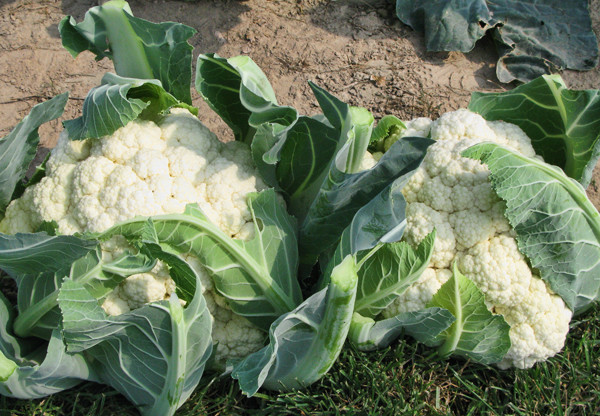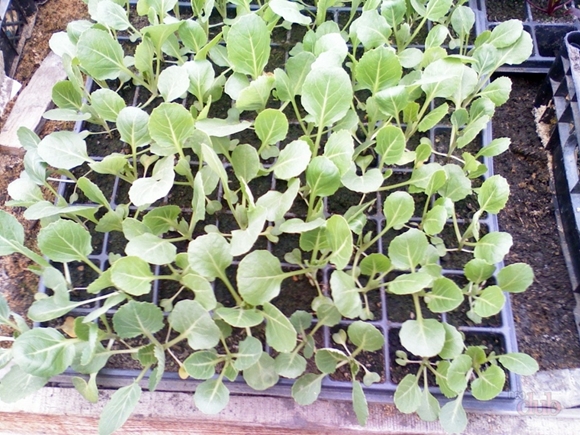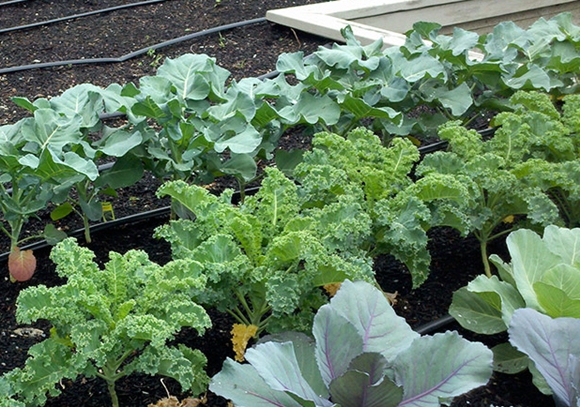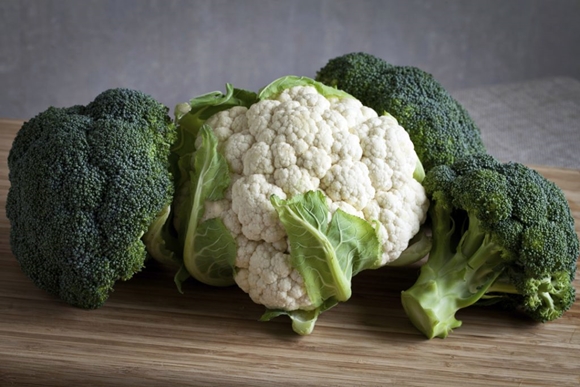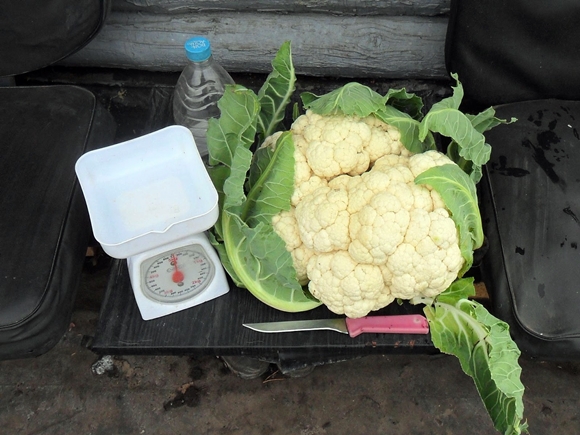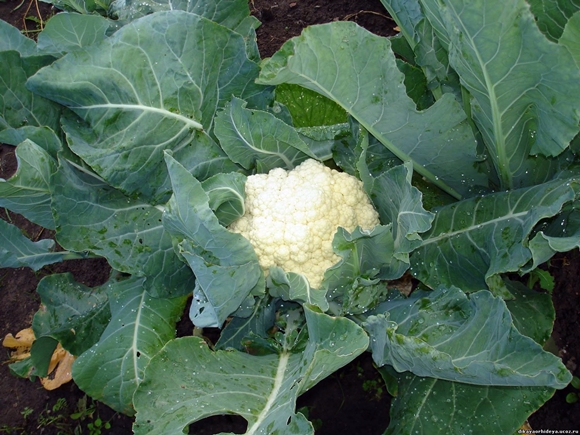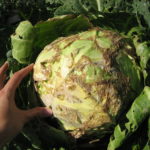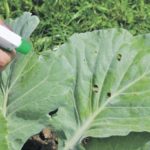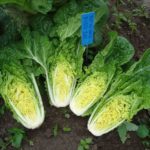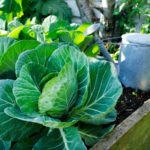There are several secrets and agricultural techniques for growing cauliflower in open ground. You should start with choosing a place for planting, suitable fertilizers and selecting the right variety. There is an option to prepare seedlings in advance or sow seeds directly into the beds.
Preparatory work on the site
Today there are many recommendations from agronomists and amateur gardeners on how to grow cauliflower in the garden. They begin to prepare by cultivating the soil in the garden where they decided to grow the plant.
To grow cauliflower in open ground, it is important to select and cultivate the land correctly. In mid-October, they select a site where cabbage is supposed to be planted next year, dig it up, weed the weeds and get rid of pest larvae. A couple of weeks after these manipulations, it is recommended to apply fertilizer. A mixture of superphosphate and potassium component is useful, or you can add wood ash.
In spring, the soil is slightly loosened, but not dug up, since cauliflower prefers a solid base. At this time, it is useful to add urea at the same time.
Features of growing cauliflower include the beneficial procedure of mulching (covering the soil where the plant is planted with organic or inorganic matter). Mulching helps keep seedlings healthy and improves soil properties.
Suitable mulch for cauliflower is:
- straw – protects the soil from overheating, retains moisture and reduces the appearance of weeds;
- with compost and humus, cabbage grows faster; in addition, the components enrich the soil with nutrients and prevent the development of many diseases;
- chopped grass - retains moisture, accelerates growth and increases productivity;
- fallen leaves - help retain heat and contain beneficial bacteria that nourish the soil and protect against pathogens;
- nettle – it contains many useful microelements that, when released into the soil, saturate the plant.
If the preparation of the land was missed, then all the same actions with the soil are done in the spring. It is recommended to add humus, urea, superphosphate, magnesium sulfate, potassium salt, boric acid and wood ash.Before planting, the soil is compacted and compacted. If this rule is followed, the heads will be dense and juicy.
Seed selection
Care begins from the moment the seeds are purchased. The variety is selected based on the climate and growing conditions. Only large, dense seeds are selected. After this, you need to wake them up. The grains are placed in a fabric bag and placed first in hot and then in cold water.
Seed care includes a disinfection procedure. It is recommended to soak the seeds for 25 minutes in a weak solution of potassium permanganate. Thanks to this, fungi and bacteria located on the seed shell die. Afterwards, the seeds are washed with plain water and left on a cloth until completely dry.
Taking into account the climate characteristics of a particular region, varieties must be planted at a certain time. For example, in the Moscow region, the best time for planting early species in open ground is the beginning of May (Snow Globe, Movir, Express). From mid-May to early April, medium varieties (Pioneer, Bravo, White Beauty) can be planted. Late species (Cortes, Amerigo) should be left at the end of June or beginning of July. There are photos of each variety on the Internet.
How long does it take to wait for a mature harvest to appear? The timing of color ripening depends on which variety was chosen. Early ripening species ripen within three months. It takes 4 months for mid-season cauliflower to ripen. Maturation of late species lasts for 5 months.
Trouble with seedlings
A good harvest will please you if you grow the seedlings yourself. It is advisable to plant seeds in soil made from peat and humus. The soil should be disinfected to get rid of pathogenic bacteria and fungi or pest larvae.You can warm the ground or water it with a solution of potassium permanganate. It is useful to fertilize the soil with superphosphate and potassium sulfate.
Holes are made in the seedling container to prevent the soil from becoming waterlogged. Then fill the containers with earth, not reaching 1 cm to the edge. In slightly moistened and compacted soil, make grooves 0.5 cm deep, between which the space should be 3 cm.
The grains should be planted in the grooves made at a distance of 1.5 cm. As soon as the seeds are planted, the container is covered with film.
On day 4-5, the first shoots should hatch, provided that the air temperature is about 20 degrees. At this stage, it is important not to miss the stretching of the stems. Therefore, the seedlings are moved to a cool place where the air temperature is no more than 6 degrees. After a few days, you can increase the air temperature to 16 degrees. In addition to everything else, this will help plants adapt to temperature changes.
Growing seedlings need constant moisture. At first, it is recommended to water with a watering can, without pressure, so as not to loosen the top layer of soil. It is recommended to add drugs to the water that prevent the development of diseases. You can use Fitosporin or Fundazol. You can lightly sprinkle the ground with wood ash.
Two weeks from the date the sprouts appear, it is necessary to pick. Only pinch long roots, without affecting weak and short branches. After the procedure, it is better to plant each sprout in a separate cup, moisten the soil and feed it. The video will help you better understand how the procedure occurs.
After 4-5 leaves appear, the plant becomes ready to be transplanted outdoors. 12 days before transplantation, a hardening procedure is carried out. It is recommended to take the seedlings outside.
Disembarkation time
Cultivation in open ground begins as soon as the cauliflower gains strength and 2 pairs of leaves develop. From this time you can start transplanting. You can plant along a ruler or in a staggered arrangement at a distance of 70 cm.
There are secrets to growing cauliflower, knowing which you can get a rich and high-quality harvest. It is better to plant in the evening or early in the morning. It is advisable that the weather be cloudy, since cabbage does not take root well in hot weather. If the weather stays like this for a long time, you should think about shading.
The distance between seedlings in the garden bed depends on the variety. Early varieties can be planted close to each other, while late varieties should be spaced further apart as they are more spreading.
When growing and caring for cauliflower outdoors, you need to follow a number of rules. After planting, the soil around the bush is compacted, moistened and a small layer of soil is placed on top so that a hard crust does not form. It is recommended to water the plant once every 6-7 days.
It is possible to grow cabbage with seeds, but this method is most suitable for regions where the weather is pampered with rain.
Furrows are made in the area prepared for the beds. In order for the seedlings to grow without problems, the distance should be approximately 55 cm. After sprouts with a pair of leaves appear, the rows are thinned out. Leave a distance between seedlings of at least 18 cm. As soon as three pairs of leaves appear, thinning is repeated. In the video you can see the thinning rules.
Agricultural technology for cauliflower is not complete without nutritious feeding. The first feeding should coincide with the first thinning.Components such as ammonium nitrate, mullein, superphosphate will contribute to the accelerated development of the plant at this stage.
After 12 days, it is recommended to repeat feeding. This time you can use an infusion of mullein and bird droppings. Nutrient components will give strength and strengthen the plant.
You can continue growing cauliflower in a greenhouse. When planting seedlings, you need to be careful with the roots and it is better to leave an earthen ball. Early types of cabbage begin to be planted in the greenhouse at the end of April.
Greenhouse cauliflower also needs to be properly cared for. Water, feed, remove weeds in a timely manner, and also prevent diseases and the proliferation of insect pests.
Hilling procedure
Another secret to growing cauliflower outdoors is hilling. For those who doubt whether the plant needs to be hilled, the answer is yes.
Growing and caring for cauliflower using this procedure helps reduce the risk of developing diseases common among cabbage, and the formed heads of cabbage do not lie on the ground and are therefore stored for a long time.
When is it best to hill cauliflower? The procedure is carried out twice in the spring. The seedling bushes are earthed up for the first time 7-8 days after planting. This will protect weak stems from adverse factors.
The second hilling is recommended to be carried out during the period of active growth of cabbage and the beginning of the formation of a head of cabbage. The hilled stem will sit more firmly in the ground and will not bend under the weight of the head of cabbage.
How to properly carry out the hilling procedure? It is better to carry out hilling in the evening, when it is dry and there is no wind. The height of the mound around the stem is approximately 30 cm.
Many vegetable growers, when caring for cabbage in open ground, begin to get rid of leaves located closer to the ground. Do I need to pick off the leaves? Agronomists consider this stage useless and even harmful for the head of cabbage. The benefits of the lower leaves are enormous. They protect the entire plant from diseases and pests, nourish the plant and promote healthy growth.
Juice appears at the site of the breakdown, which attracts attention with its pest smell and any infection easily penetrates. Only when it is too rainy, in order to avoid rotting of the entire plant, is it permissible to remove the leaves of cauliflower that are close to the ground. After this, it is imperative to disinfect the plant. You can use wood ash.
Harvesting
Fresh and dense heads of cabbage can be harvested until winter, but only if the technology for growing cauliflower has been followed.
When to harvest? Heads of cabbage are harvested in dry, sunny weather as they reach their final ripening. Ripeness in certain cabbage varieties occurs at different times.
If early types of cauliflower were planted in the ground, then the ripening period will fall at the end of June, beginning of July. At this time, you can remove the formed head of cabbage. Late varieties ripen most often in September.
How can you determine when it’s time to harvest a head of cabbage? Maturity is determined by the size of the head and its color. As soon as the head of cabbage turns white, it can be cut off. In the photo you can see the finally formed head of cabbage.
If the leaves are powerful and the rosettes are strong, then there is a chance to harvest a second harvest of cauliflower. For this purpose, shoots are cut off at the base of the stalk, leaving two strong ones. In the future, care is also accompanied by watering and fertilizing.
You can re-sow the soil with seeds.In July, as soon as the harvest is harvested, the beds are again sown with cauliflower seeds. By the beginning of autumn, the bushes will already gain strength and begin to form heads of cabbage. Before the onset of frost, those heads of cabbage that have managed to grow and gain strength for the growing procedure are selected.
A few days before transplanting, the bed is thoroughly watered. Two days later, plants with strong leaves and a formed ovary of at least 3 cm are selected. They must be dug up together with a lump of earth. The best option would be to grow cabbage in a polycarbonate greenhouse.
Depressions are made in the ground not far from each other. It should be deepened to the lower leaves. Ripening should take place without light. Therefore, you need to create a structure that will not allow light to pass through.
If the temperature in the greenhouse is about 11 degrees Celsius, then ripening will take place within a month. During this time, caring for cauliflower continues. The soil needs to be regularly watered, ventilated, and bad leaves should be plucked from the plant.

